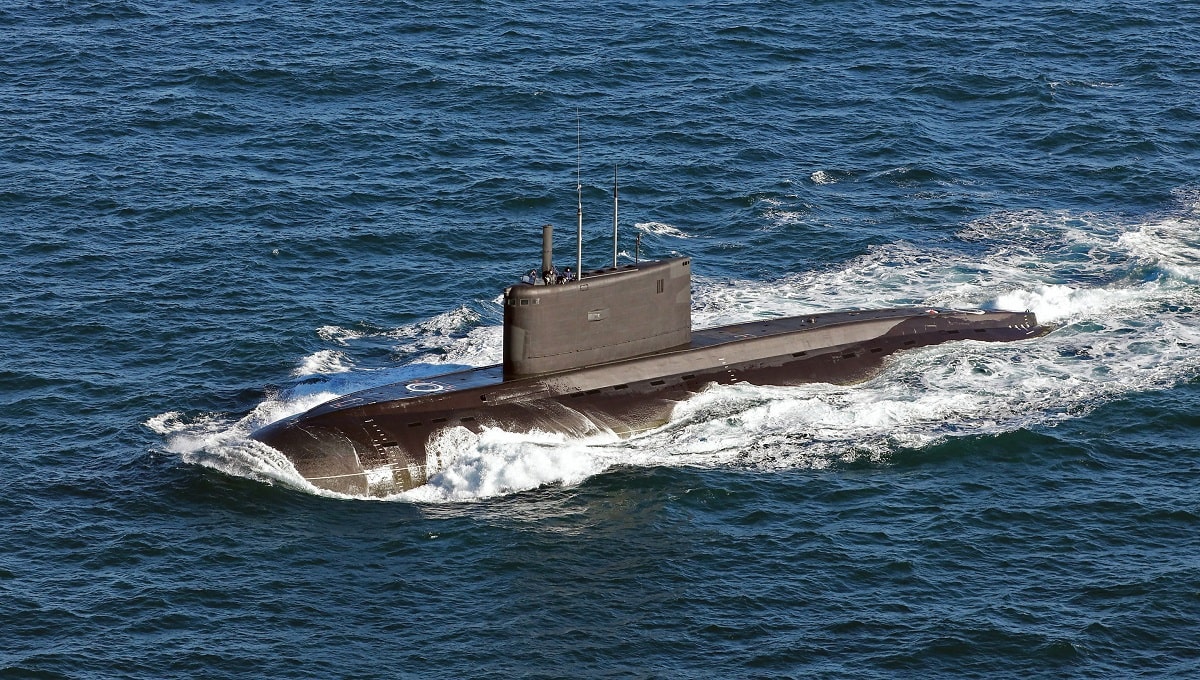Russia is sending another relic to the war zone. This time it is a submarine first commissioned in 1990 that supposedly has been upgraded to launch the Kalibr cruise missile. The sub, called the Alrosa, is the oldest in the Black Sea fleet. And it’s not even ready for combat, as the Russian navy still has to test it extensively. It has been out of action for eight years, after delays to the work that originally scheduled it to re-enter service in 2017.
Clean Off the Cobwebs
In addition to the Kalibrs, Jane’s Defence said the Alrosa likely had additional repairs and upgrades to include an “enhanced sensor, command-and-control, communications, and safety equipment.”
Pump-jet Propulsion Is Unique to the Class
The Alrosa is technically a subvariant of the Kilo-class diesel-electric sub, but its propulsion system is known as a “pump-jet propulsor” that is different than the regular propellor older Russian subs are equipped with. This system is quieter than the baseline diesel-electric. A pump-jet is usually heavier and more expensive than the standard propellor. The pump jet is also equipped on the Russian fourth-generation Borei-class of ballistic missile subs.
Not a Big or Fast Sub
The Alrosa is 250 feet long, with a draught of 21 feet, and a displacement of 2,300 tons when surfaced and 3,040 tons when submerged. It only has a crew of 52 sailors with a slow speed of 20 knots. Cruising capacity is 45 days.
Will It Be Ready Soon?
Although social media photos and videos of the Alrosa showed it leaving port, the boat is not ready for battle, and it is not clear when it will enter operational service. Knowing the Russian Navy’s tardy track record, this could take months. Russia could certainly use more Kalibr missiles launched from submarines, and the Alrosa will be a welcome addition to the fleet, even though it’s an old boat that has no recent service record.
Kalibrs Are Valuable If This Sub Can Launch Them
Kalibr cruise missiles, on the other hand, are effective and accurate. In June, the Russian military said at least one Russian Kalibr destroyed a Ukrainian arms depot that was chock full of valuable weapons such as anti-tank missiles and artillery pieces.
The Kalibr can be compared to the venerable American Tomahawk cruise missile. The Kalibr can fly up to MACH 3 during its terminal phase after skimming the sea 10 feet off the waves. The Kalibr’s range is 930 to 1,550 miles. Its warhead weighs 990 pounds. The missile is 20 feet long. Kalibrs were used to blast insurgents and terrorists in Syria.
Too Late for the Alrosa?
While Kalibr cruise missiles have been a mainstay for Russian forces, the Alrosa itself is not going to make much of a difference in this war. I’m not convinced it will be ready for combat operations any time soon. This sub has been out of action for eight years. It’s not likely to recover quickly with a few trials and tests. It will be quieter than the other boats in the Kilo-class as its propulsion system is somewhat modern.
However, Russia is undeterred when it comes to bringing on military hardware that has been offline. Just take a look at all the old reserve tanks the Kremlin is sending to the front. Submarines are much more complex than tanks to be sure. So, Russia will have its hands full with the Alrosa, even though the Kalibrs will be a valuable weapon for Vladimir Putin’s navy if they ever launch from this sub.
Now serving as 1945’s Defense and National Security Editor, Brent M. Eastwood, PhD, is the author of Humans, Machines, and Data: Future Trends in Warfare. He is an Emerging Threats expert and former U.S. Army Infantry officer. You can follow him on Twitter @BMEastwood.

